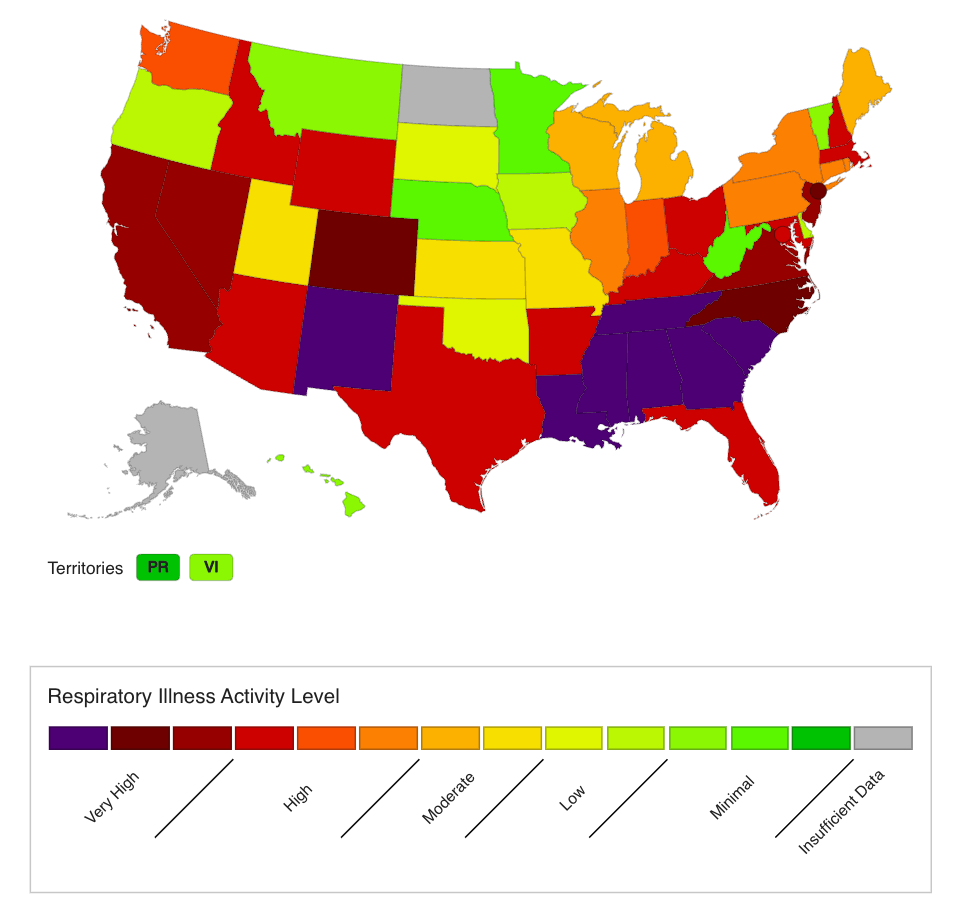Hospitals Reinstate Mask Guidelines Against Triple Threat of Respiratory Illnesses
In response to a surge in cases of COVID-19, flu, and RSV, hospitals are reinstating mask guidelines to avoid adverse capacity outcomes and staffing shortages seen in prior years.
Hospitals across the nation are reinstating mask guidelines in response to an uptick in cases of COVID-19, flu, and respiratory syncytial virus (RSV), in what some are calling a "tripledemic"; a term that aptly communicates the collective toll that the respiratory illnesses are exacting on health care systems.1
What’s the Issue?
Based on data from December 28, 2023, Americans in over half the country are currently living in states that the CDC has classified as having a “high” or “very high” risk of respiratory illness activity.2
Level of respiratory illness activity across the US as of December 28, 2023. (Source: CDC)

Some health care officials are citing the increased frequency of indoor gatherings and holiday travel that takes place at this time of year as part of the reason for the surge.3
- In Los Angeles, a public health order was put in place requiring all health care personnel to wear masks near patients and patient care areas after COVID-19 hospital admission levels satisfied the “medium” threshold of 10 and 19.9 new COVID-19 hospital admissions per 100,000.4
- In response to the rise in respiratory illness cases, the New York City Health Commissioner reinstated mask mandates in all the city’s major health care facilities, including 11 public hospitals, 30 health centers, and 5 long-term care centers.5
- Mass General Brigham, the largest health system in Massachusetts, is now requiring patient care workers and “strongly encouraging” patients and visitors to wear masks.3
Why it Matters
Reinstated mask guidelines help relieve some of the strain placed on health care systems in the throes of the tripledemic by controlling the spread of each virus. By doing so, mask guidelines allow health care staff to effectively provide care while maintaining their own safety, avoiding adverse capacity outcomes and staffing shortages seen in prior years.
- In 2021, the Omicron surge caused major capacity issues for health care facilities across the nation, leading some patients to receive care in the hallways of hospitals. Hospital CEOs in Minnesota warned the public in a newspaper ad that “access to care [was] being seriously threatened by COVID.”6
- During another surge in 2021, a patient with COVID-19 died while waiting for a bed to become available in the ICU at a hospital in Oregon, even after the hospital expanded its ICU to accommodate for the swell of patients.7
- A hospital in New Jersey called upon the national guard and FEMA for assistance with staffing after 6000 hospital staff members got COVID-19 during the week leading up to New Year’s Day 2023.8
Expert Commentary
- “What we don’t want is staffing shortages, right? When we saw the Omicron wave in 2022, the biggest issues were not only people getting sick, but that we had a lot of frontline health workers, they were out with COVID,” said New York City Health Commissioner Ashwin Vasan, MD.5
- “If people need to use [the] emergency department, they absolutely should, but we’re in a moment now where capacity definitely is a big topic of focus for hospitals that are trying to both maintain their ability to take care of patients with severe illness as a result of these pathogens, but also be able to manage routine care as well,” said John Brownstein, MD, chief innovation officer at Boston Children’s Hospital.3
In-Depth Insights
Late in 2023, the CDC issued a Health Alert Network Health Advisory for health care providers regarding low vaccination rates against influenza, COVID-19, and RSV. The agency paired the alert with a call to “leverage all available tools to increase immunizations against [the respiratory illnesses]” to improve patient outcomes.9
- According to data from the CDC from mid-December, only 44% of US adults had received flu shots and only 19% had received an updated COVID-19 shot.10
- To date, the CDC has reported that only 17.4% of adults 60 years or older have received an RSV vaccine.11
- On behalf of results from a nationally representative sample of adults in the US that reported reasons like lack of provider recommendation, concerns about adverse effects, vaccine fatigue, and lack of time to get vaccinated as reasons for low vaccine uptake, the CDC released communication tools and templates to help initiate the vaccination conversation with patients.12
Extra Reading
For more on this issue, check out these articles.
- https://apnews.com/article/covid-flu-hospital-masks d15543a3d77a48bf8d985433725c4e75 (AP News)
- https://emergency.cdc.gov/han/2023/han00503.asp (CDC)
- https://www.cdc.gov/respiratory-viruses/tools-resources/health-care-providers.html (CDC)